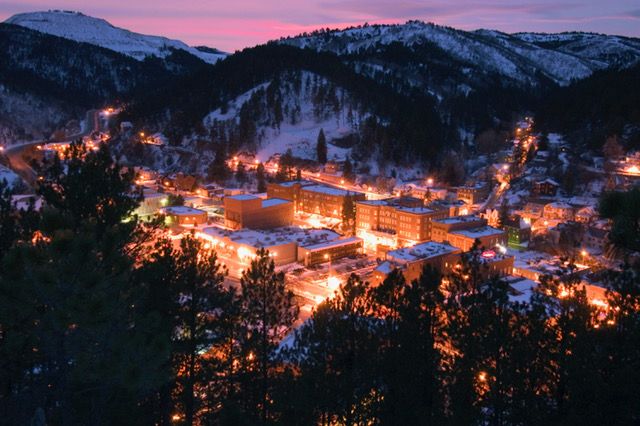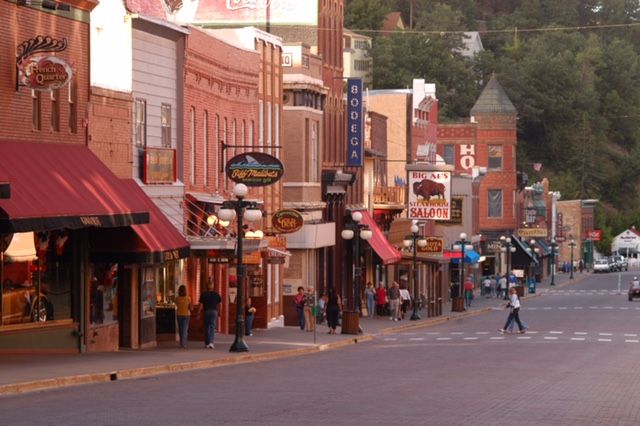As Deadwood saunters into its 30th year with legalized gaming, the Wild West town made famous by Wild Bill Hickok, Calamity Jane and a posse of other western legends, doesn’t resemble its former self.
The historic place perched in the highest reaches of the northern Black Hills once glittered with gold from a rush for riches that began in 1876, bringing with it saloons, shootouts and rabble-rousers, as well as a crowd of would-be miners, merchants and madams, all searching for their private Eldorado.
But over a century of hard-living and high-life, the gold veins bled out and much of the crowd moved on. After a series of floods that nearly drowned the town and fires that gutted its Victorian downtown, many left Deadwood for dead.
By the mid-1980s, travelers searching for the real Old West found a town with boarded-up storefronts and crumbling facades. A major fire in December 1987, seemed to be a fatal blow. On that frigid night, the century-old Syndicate Building at the corner of Lee and Main streets was engulfed in flames and despite the efforts of volunteer firefighters, by morning, a half-block of Main Street had been reduced to a pile of smoldering debris.
But then a funny thing happened on the way to the funeral home. The town once known as the wildest and wooliest on the western frontier, a place slowly slipping into oblivion, simply refused to die.

Resuscitating a town
Tom Blair, who served as Deadwood’s mayor from 1984-1989, remembers the day three decades ago when a stranger threw his town a lifeline. He was attending an economic development conference in Hot Springs, commiserating with other municipal officials about the sad state of affairs.
“We were hurting for money and we were going downhill fast,” Blair said. “At lunch that afternoon, I was talking with the guest speaker, who had been to Deadwood. He said, `Why don’t you do something different than anybody else?’ I said, `Like what?’ and he responded, `Why don’t you put gambling up and down the street,’ and it was like somebody turned the light on.”
Blair returned home and enlisted the support of his wife, Linda, and fellow Deadwood advocates including Mike Trucano, Bill Walsh, Melodee Nelson, David Larson, Mary Dunne and Betty Whittington.
The ensemble lobbied legislators, then brought their plan to use gaming as a way to rejuvenate the decaying community to the 1987 Legislature. Lawmakers declined to place the measure before voters. Undeterred, the group, which had come to call itself Deadwood You Bet, hit virtually every county fair and civic organization in South Dakota in the ensuing months and gathered more than 30,000 signatures on petitions to bring their ambitious plan to state voters.
“We had a dying town 12 miles off the interstate, and no money to do anything, no commerce, and almost all of the buildings were boarded up,” said Mike Trucano, 62, a life-long resident of Deadwood. “We were young and dumb and thought if we could get legal gambling in our town, perhaps it would help things.”
On Nov. 8, 1988, 64 percent of South Dakota voters cast ballots saying “yes” to Deadwood gaming. The following April, Deadwood’s electorate approved limited stakes gaming for their town by a 3-to-1 margin.
When the sun rose over Mt. Moriah Cemetery – Deadwood’s own Boot Hill – on Nov. 1, 1989, it signaled a new dawn for the town most thought all but dead. At high noon in front of the fabled Franklin Hotel, western re-enactors pulled six-guns from their holsters, pulled the triggers and signaled the start of something entirely new.
The move toward legalized gaming was then, revolutionary. On that day, Deadwood became only the third venue in the country to permit legal wagering, along with Atlantic City, N.J., and the state of Nevada.

Gambling expansion spawned dozens of casinos
Initially, proponents of legalized gambling envisioned a few quaint gaming halls scattered along Main Street. But what actually happened startled even the most optimistic.
Gaming consultants had projected that, with a $5 bet limit, operators of the original 14 casinos could reasonably expect $2 million in wagers in the first year. Bettors did that in a week, eventually plunking down $13.8 million in cash in the first month. With the summer tourist season in full swing by the next July, gamblers had bet as much as $1.2 million in one day and have wagered an astounding $145.4 million since the advent of Deadwood gaming, more than 70 times projections.
In the first year, nearly 80 casinos opened their doors, jettisoning some 40 retail shops. Virtually every establishment was short of help, real estate prices skyrocketed and applications for building permits overtaxed limited municipal staff.
“For a while we lost our sense of community, with many of the workers involved in the industry not living here,” Trucano admitted. “We certainly lost some retail – car dealerships, shops and a grocery store.
“But we gained a brand-new infrastructure, including water, sewer and streets, and our public buildings, once neglected, are looking real good today.”
In fact, over the past 30 years, gaming has helped fuel a modern-day renaissance in Deadwood, injecting an estimated $350 million in public and private dollars into myriad projects ranging from a transformed $6 million city recreation and aquatic center and the $4.8 million comprehensive restoration of Mt. Moriah Cemetery to a successful resort/conference center complex called The Lodge at Deadwood that has helped steadily increase visitation to town, particularly during the shoulder and off-seasons.
With its $6-7 million annual share of gaming proceeds, Deadwood also invested nearly $1 million in a three-year Chinatown archeological investigation that yielded more than 400,000 artifacts; helped establish and fund Deadwood History Inc., an umbrella organization that runs the community’s four major museums, including the new $7 million Days of ’76 Museum; and contributed $1.7 million to the Deadwood Mountain Grand, a project that transformed the Homestake Gold Mine’s 1906 Slime Plant into a $50 million hotel, casino and entertainment complex.
Among more recent projects that relied on gaming dollars were the city’s $2.5 million investment in the state Department of Transportation’s $12 million reconstruction of Highway 85. Municipal funds were used to build new parks and trolley stops, bury power lines, add period lighting and generally beautify the southerly gateway to town where more than 40 percent of its visitors arrive. Gaming proceeds also were used to upgrade facilities at the Days of ’76 Rodeo Grounds.
“Approximately $350 million has been reinvested in the community in terms of development and historic preservation projects,” said Deadwood Historic Preservation Officer Kevin Kuchenbecker, who has been on the job since 2006. “That’s incredible for a town of 1,200 people.
“And, Deadwood is one of 2,500 National Historic Landmarks, which puts us with the Lincoln Memorial, Mount Vernon, Gettysburg and other iconic landmarks,” Kuchenbecker added. “It’s the cream of the crop.”
Deadwood gaming dollars have found their way into numerous public and private projects, ranging from retaining wall, window and paint grants to rehabilitation of historic homes and commercial properties. Funds also have rippled well beyond city limits.
Tens of millions of dollars in tax revenues generated by gaming have been funneled into state, municipal and county coffers, as well as schools, the South Dakota Department of Tourism, and gambling-addiction programs. Dozens of historic properties scattered across South Dakota also have been recipients of Outside of Deadwood grants.
“We give money all across the state,” said Blair, who served as mayor when gaming was legalized. “I went to my hometown of Groton last summer and there were two $15,000 grants that had gone to two local churches. If there was ever a time I was proud of what we did, it was standing on Main Street of my old home town and seeing those two restored churches.”
“For a while we lost our sense of community, with many of the workers involved in the industry not living here. We certainly lost some retail – car dealerships, shops and a grocery store. But we gained a brand-new infrastructure, including water, sewer and streets, and our public buildings, once neglected, are looking real good today.” Mike Trucano, Deadwood businessman
Challenges accompanied gaming growth
Deadwood’s gaming industry built the city a solid foundation, which has helped it stand against a series of challenges over the years.
The closing of Homestake Gold Mine in 2002 cost hundreds of jobs in the area and led to population declines.
In the late 1990s and early 2000s, as other states began offering gaming, fewer players came to Deadwood, gambling revenues began to flat-line and visitor numbers and dollars spent stabilized. Smaller gaming operations were consolidated into larger gaming companies and today a handful of larger companies own most of the town’s major casino operations.
In 2013, actor Kevin Costner sold 1,000 acres of land he owned near town. The site was designed to be a first-class gaming destination, called the Dunbar Resort, but never got off the ground. In 2017, Costner closed his Midnight Star, a popular spot on Main Street.
By 2013, Deadwood’s foray into gaming had created 1,686 jobs with an annual payroll of $38 million, according to a study by the American Gaming Association. While that number of jobs has been whittled down to about 1,300 due to consolidation and, in some cases, closure of gaming properties, the community today still relies on help from workers who live in Lead, Spearfish, Sturgis and Rapid City, Blair said.
While Deadwood was only the third venue in the U.S. to offer legal wagering in 1989, a wave of gaming has since swept the nation. Most Americans can find a casino within 150 miles of their house and only two states – Hawaii and Utah – have failed to get in the game.
To remain competitive, Deadwood eventually succeeded in increasing bet limits from the original $5 to $25, then to $100, and ultimately to $1,000. In 2014, the Deadwood Gaming Association championed a successful constitutional amendment that allowed roulette, craps and keno to be added to the town’s stable of games. In January, the state Legislature will be asked to approve a ballot measure that would allow South Dakota voters to augment the town’s current offerings by adding sports betting to the mix.
But, even with new games of chance, community leaders say they recognize that Deadwood’s strength and allure has always been found in its history and mystery.
“Gaming is our funding source for historic preservation, set up through the state constitution 30 years ago,” Kuckenbecker said. “It’s the engine that has allowed us to continue to uncover and develop stories and history tied to Deadwood.”
In mid-December, the Deadwood City Commission approved a comprehensive plan, last upgraded in 2001, that will provide a roadmap and guiding principles for the town’s future in terms of ongoing preservation, recreation, economic development and heritage tourism.
“Preservation is never-ending,” Kuchenbecker said. In addition to regular maintenance and repairs and re-visiting rehabilitation projects completed three decades ago, the plan also addresses compliance with ADA requirements and sidewalk enhancements, he noted.
But what has local residents and city officials most excited of late are plans for a new Outlaw Square on Main Street, built on the current location of the Franklin Motor Lodge and the former site of the Deadwood Theater and City Hall, both of which burned to the ground in 1952.
“Outlaw Square will include an ice rink, stage, gazebo and create opportunities for the enhancement of living history, festivals and activities that keep downtown and historic Main Street alive and vibrant,” Kuchenbecker said. The fast-track $5 million project is projected to be completed by Labor Day weekend, he added.
While plans to commemorate the 30th anniversary of Deadwood gaming in November are in their infancy, supporters of the innovative concept of returning the once-dying community to its original luster say they take great satisfaction in what the town has become.
“We gained a lot and lost a little as a community,” Trucano said. “We brought something new to the table. With gaming money, we’ve been able to build on Deadwood’s historical story and bring it to life. We have a healthy town today, a good town of which we, as citizens, ought to be proud.”




